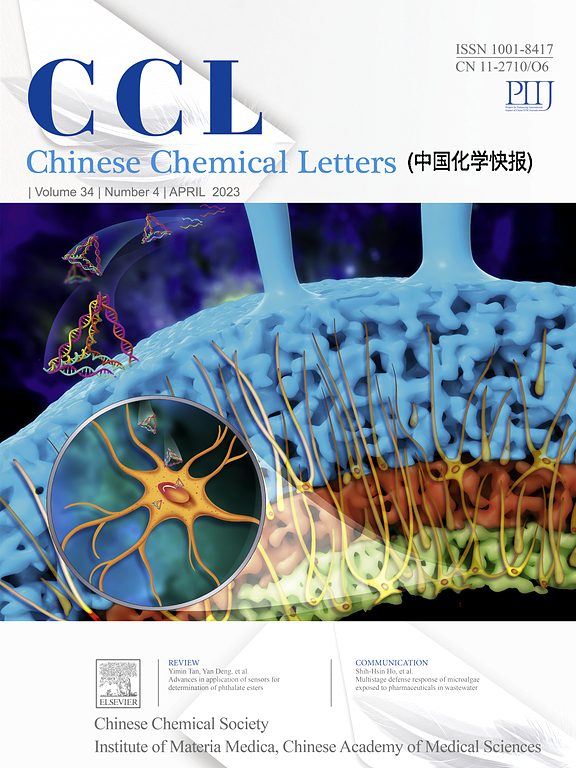oh功能化alk-Ti3C2 MXene/RuOx双活化途径促进制氢
IF 9.4
1区 化学
Q1 CHEMISTRY, MULTIDISCIPLINARY
引用次数: 0
摘要
通过精心设计活性物质与载体界面的局部环境,优化其对H2O分子和BH4 -阴离子的吸附,为通过双活化途径促进NaBH4水解制氢提供了理想的策略。基于d波段中心分析和电子转移计算的理论预测表明,引入-OH官能团可诱导电荷再分配,提高alk-Ti3C2上的电荷浓度,促进双活性物质H2O分子和BH4 -阴离子的吸附和活化。受这些预测的启发,优化后的alk-Ti3C2/RuOx催化剂表现出最高的催化活性,氢生成率(HGR)为9468 mL min−1 gcat.−1。实验数据和理论分析均证实-OH官能团促进了alk-Ti3C2上的电荷富集,优化了对H2O分子和BH4 -阴离子的吸附,降低了* oh - ts中间体的解离能垒。这种双激活途径机制降低了NaBH4水解的活化能,显著提高了HGR性能。这些发现在理论见解的指导下,确立了alk-Ti3C2/RuOx是NaBH4水解的高效催化剂,并为未来的制氢催化剂设计提供了坚实的基础。本文章由计算机程序翻译,如有差异,请以英文原文为准。
Dual activation pathways based on OH-functionalized alk-Ti3C2 MXene/RuOx boosting the hydrogen generation
A meticulous design of the local environment at the interface between active species and the support, aimed at optimizing the adsorption of H2O molecules and BH4− anion, offers an ideal strategy for enhancing hydrogen generation via NaBH4 hydrolysis through dual activation pathways. Theoretical predictions based on d-band center analysis and electron transfer calculations suggest that introducing -OH functional groups induce charge redistribution, enhancing charge concentration on alk-Ti3C2 and facilitating the adsorption and activation of dual active species, H2O molecules and BH4− anion. Inspired by these predictions, the optimized alk-Ti3C2/RuOx catalyst demonstrates the highest catalytic activity, achieving a hydrogen generation rate (HGR) of 9468 mL min−1 gcat.−1. Both experimental data and theoretical analyses confirm that the -OH functional groups promote charge enrichment on alk-Ti3C2, optimizing the adsorption of H2O molecules and BH4− anion, and reducing the dissociation energy barrier of the *OH![]() H-TS intermediate. This dual activation pathways mechanism lowers the activation energy for NaBH4 hydrolysis, significantly enhancing the HGR performance. These findings, guided by theoretical insights, establish alk-Ti3C2/RuOx as an efficient catalyst for NaBH4 hydrolysis and provide a strong foundation for future hydrogen generation catalyst designs.
H-TS intermediate. This dual activation pathways mechanism lowers the activation energy for NaBH4 hydrolysis, significantly enhancing the HGR performance. These findings, guided by theoretical insights, establish alk-Ti3C2/RuOx as an efficient catalyst for NaBH4 hydrolysis and provide a strong foundation for future hydrogen generation catalyst designs.
求助全文
通过发布文献求助,成功后即可免费获取论文全文。
去求助
来源期刊

Chinese Chemical Letters
化学-化学综合
CiteScore
14.10
自引率
15.40%
发文量
8969
审稿时长
1.6 months
期刊介绍:
Chinese Chemical Letters (CCL) (ISSN 1001-8417) was founded in July 1990. The journal publishes preliminary accounts in the whole field of chemistry, including inorganic chemistry, organic chemistry, analytical chemistry, physical chemistry, polymer chemistry, applied chemistry, etc.Chinese Chemical Letters does not accept articles previously published or scheduled to be published. To verify originality, your article may be checked by the originality detection service CrossCheck.
 求助内容:
求助内容: 应助结果提醒方式:
应助结果提醒方式:


